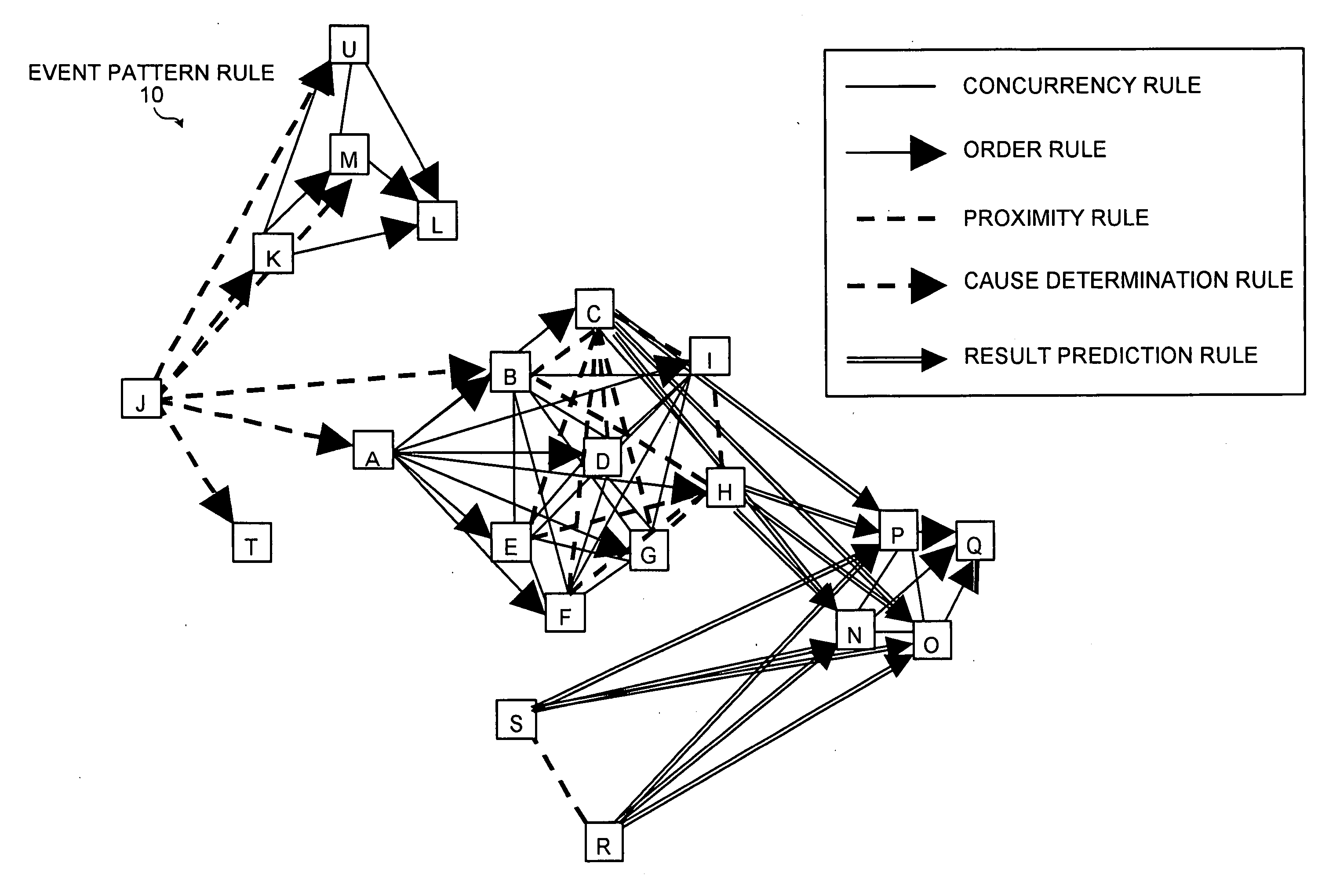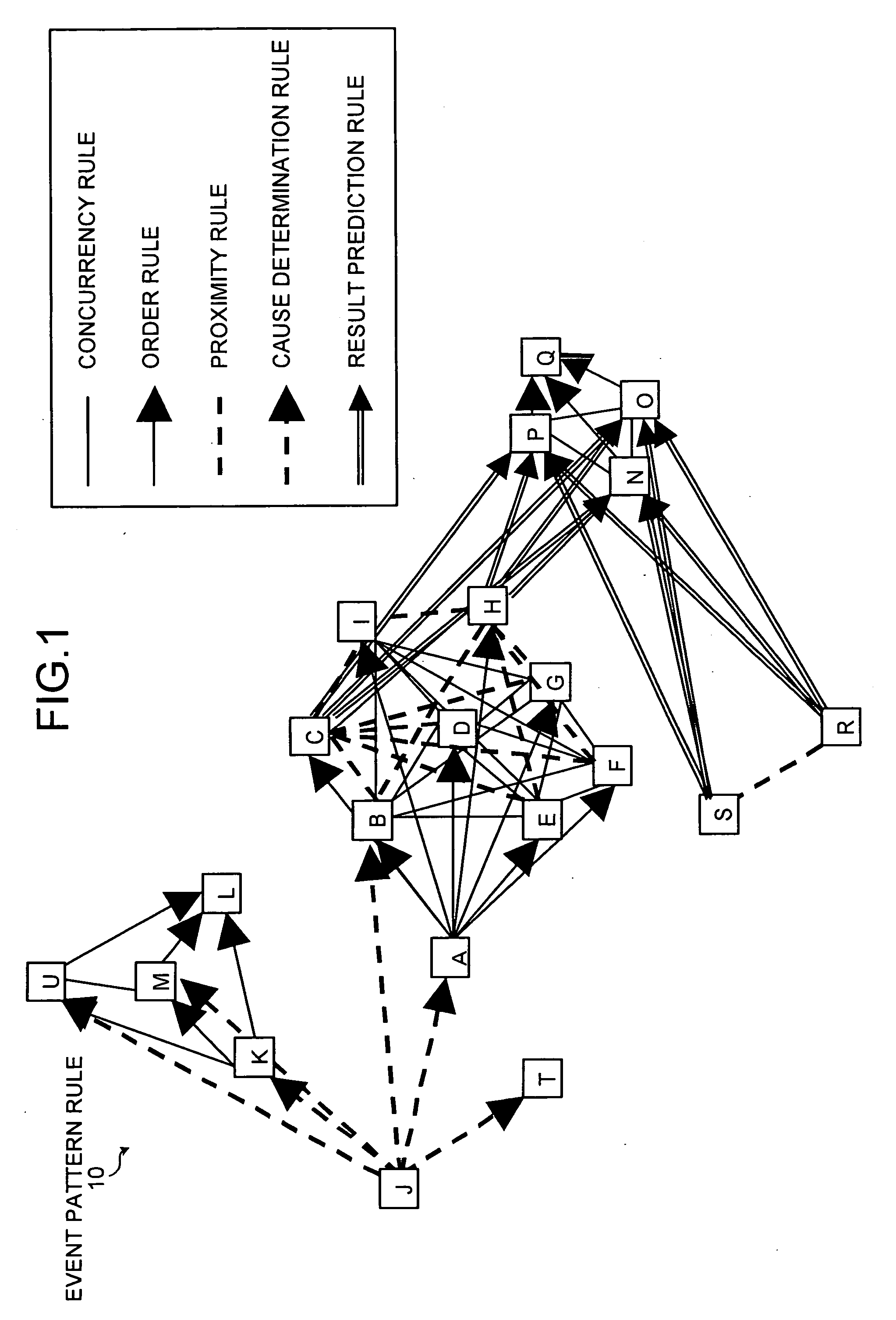Apparatus, method, and computer product for pattern detection
a pattern detection and apparatus technology, applied in the field of apparatus, can solve the problems of difficult to provide detailed information to an event occurrence pattern, difficult to detect an occurrence pattern, and difficult to strongly support a work for extracting further detailed information
- Summary
- Abstract
- Description
- Claims
- Application Information
AI Technical Summary
Benefits of technology
Problems solved by technology
Method used
Image
Examples
first embodiment
[0114] As described above, in the first embodiment, the probability calculating unit 214c and the pair rule producing unit 214d detect an event pattern rule and output the detected event pattern rule. The event pattern rule is detected based on an event log based upon information on plural kinds of relationships defined among events, such as the simultaneity rule, the order rule, the proximity rule, the cause determination rule, and the result prediction rule. As a result, detailed information on an occurrence pattern of an event can be extracted from the event log.
[0115] Moreover, the information on the plural kinds of relationships is information defined based upon the occurrence times of events and the occurrence probabilities of the events. As a result, the relationship between events can be set flexibly based upon occurrence times of the events and occurrence probabilities of the events. Moreover, detailed information on an occurrence pattern of an event can be extracted.
[0116...
second embodiment
[0119] In the first embodiment, an event pattern rule is prepared by connecting pair rules. As another approach, it may be whether connection of pair rules are valid, and only an even pattern rule constituted of connection of valid pair rules is output. This approach will be explained below in detail as the present invention.
[0120] In the second embodiment, the composition rule producing unit 214e of the pattern detecting device 21 determines whether connection of rules is valid based upon a connection condition preliminarily defined before connection of rules, and performs connection of rules, when an affirmative determination is made.
[0121] For example, it is assumed that a pair rule (A, B) including an event belonging to category A and an event belonging to category B, a pair rule (B, C) including an event belonging to category B and an event belonging to category C, a pair rule (C, D) including an event belonging to category C and an event belonging to category D, and a pair ru...
third embodiment
[0142] In the first and second embodiments, times ts and te, which define nearness in occurrence time between two events, are set in advance in the time constraint Ft (t1, t2). In an actual analysis of an event log, however, since a range of occurrence times found between events is frequently unclear, it is difficult to set the times ts and te in advance in some cases. Proper time interval can be set automatically. This approach will be explained below as the present invention.
[0143] In the third embodiment, the time constraint Ft (t1, t2) is defined as t1−w≦t2≦t1. Here, w represents a threshold determining a time interval where a relationship is found between events, and it is a value automatically set in a method described below. In this case, the co-occurrence probability P(c1, c2, ts, te) is represented as P(c1, c2, −w, 0).
[0144] In the pattern detecting processing according to the third embodiment, the probability calculating unit 214c of the pattern detecting device 21 obtain...
PUM
 Login to View More
Login to View More Abstract
Description
Claims
Application Information
 Login to View More
Login to View More - R&D
- Intellectual Property
- Life Sciences
- Materials
- Tech Scout
- Unparalleled Data Quality
- Higher Quality Content
- 60% Fewer Hallucinations
Browse by: Latest US Patents, China's latest patents, Technical Efficacy Thesaurus, Application Domain, Technology Topic, Popular Technical Reports.
© 2025 PatSnap. All rights reserved.Legal|Privacy policy|Modern Slavery Act Transparency Statement|Sitemap|About US| Contact US: help@patsnap.com



